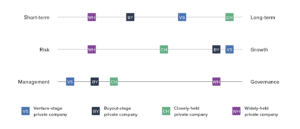Long-term companies recognize the breadth of board design options employed globally and leverage them to focus on next-generation governance challenges rather than remaining anchored to past practices.
The board is the connection between investors and corporations. In private companies, shareholders are typically in the boardroom. In publicly listed companies, shareholders vote for directors, and directors govern companies. Directors, executives, and investors depend on each other to be able to focus on the long term.
Boards need to find a balance between providing freedom to enable long-term value creation through entrepreneurship and overseeing resilience to ensure long-term sustainability. They can get it wrong in the short run by allowing too much discretion or insisting on too much process. The trick is to find the right balance to unlock experimentation, feedback, learning, and growth while safeguarding against unintended outcomes.
Indeed, many public company boards overcorrected away from entrepreneurship towards control in the latter part of the twentieth century to address concerns about “imperial CEOs” running companies as they saw fit. Generating resilient long-term value creation is a challenging mandate.
Long-term companies broaden their frame of reference and think creatively when they set up their boards to meet the needs of their executives and corporate strategy. Critical dimensions to target include:
- Time horizon
- The juncture between risk appetite and growth objectives
- The relative importance of governance and management roles
These should be set jointly, not individually – the companies’ choices must be complementary to one another and well-matched among their board, executive team, and corporate strategy.
In the chart below, we characterize four board archetypes to illustrate common combinations. Boards of widely held public companies tend to be short-term oriented, more risk averse, and more governance focused than their closely held and private market peers. Boards of more closely held companies, commonly in the form of family or founder held firms, permit a long-term orientation alongside an increased focus on management as well as the ability to target the controlling shareholders’ risk appetite. Private equity boards are transaction oriented with an intermediate time horizon. Venture capital boards tend to be more involved in management and more growth focused than buyout boards as befits the needs of startups.

The notion that the public-company board model is the sole approach for corporations to achieve success is misleading
Looking bottom-up at the boards of real-world companies, rather than top-down based on legal or policy norms, reveals a wide range of options. One method for doing so groups companies based on common structure and practice. Another method considers successful public companies with provocative governance practices. Below, we share some preliminary observations from both approaches that begin to illustrate the range of governance choices available to companies and investors.
We loosely identify and characterize five types of boards in Table A. These simple examples encompass public and private boards, one- and two-tier boards, a range of board sizes, varying degrees of involvement and incentives, a range of emphases on governance and management, differing levels of investor involvement, and the use of one or more share classes to provide control.
Indeed, there are far more levers currently used to align boards with management and strategy than delineated above. These span board structure, committees, diversity, qualifications, criteria for elections, expectations, evaluations, criteria for dismissal, compensation, share ownership, agenda, resources, engagement with staff, engagement with shareholders, engagement with stakeholders and dynamics. Truly, the range of options for board governance is wider than commonly perceived.
For practical examples, we share some key governance features of six high performing public companies in Table B below.
While a detailed case study of how these boards function exceeds the scope of this article, considering a set of key characteristics from a cross-company perspective reveals:
- Novo Nordisk is owned by a public benefit foundation.
- Tesla and TSMC have taken very different approaches to working with visionary leaders and these approaches have evolved as the companies matured.
- Tokyo Electron employs a two-tier board in Japan and recently conducted a reorganization to elevate the quality and timeliness of board decision-making.
- Novo Nordisk, Volvo AB and Stellantis employ multiple share classes to separate voting and cashflow control with Stellantis issuing loyalty shares to favor long term investors.
- TSMC and Stellantis have built boards to balance the ownership interests of governments, families/founders, and companies alongside institutional and retail investors.
- Novo Nordisk and TSMC have taken different approaches to further their competitive technology edges: Novo Nordisk employs a board-level research committee while most TSMC board members have PhDs with deep technical expertise.
Conclusion
A well-matched board cannot be absolutely entrepreneurial – exclusively focused on long time horizons, growth-oriented, and heavily involved in management – nor so focused on resilience as to squash risk over short horizons from a distant, governing posture. Long-term boards want to build companies that are entrepreneurial to create value and resilient to build confidence in the direction of travel even during the inevitable period of underperformance. This is how companies align boards with strategy.
There is no one-size-fits-all solution to this challenge. Specifically, the current public company board model is not the only option that corporations can use to generate strong performance. Successful companies around the world, under different ownership structures, and in different stages of growth use markedly different governance practices. The first step for companies and investors toward making longer-term choices and establishing next-generation board governance is to recognize and understand that choices truly are available. Future research may identify levers for making these choices and a select set of fundamental, underlying qualities of long-term corporate boards.
Ultimately, companies’ board practices are choices, whether made knowingly or unknowingly. Companies and investors have important, long-term choices to make so that boards focus on next-generation governance challenges rather than remaining anchored to past-generation practices.




